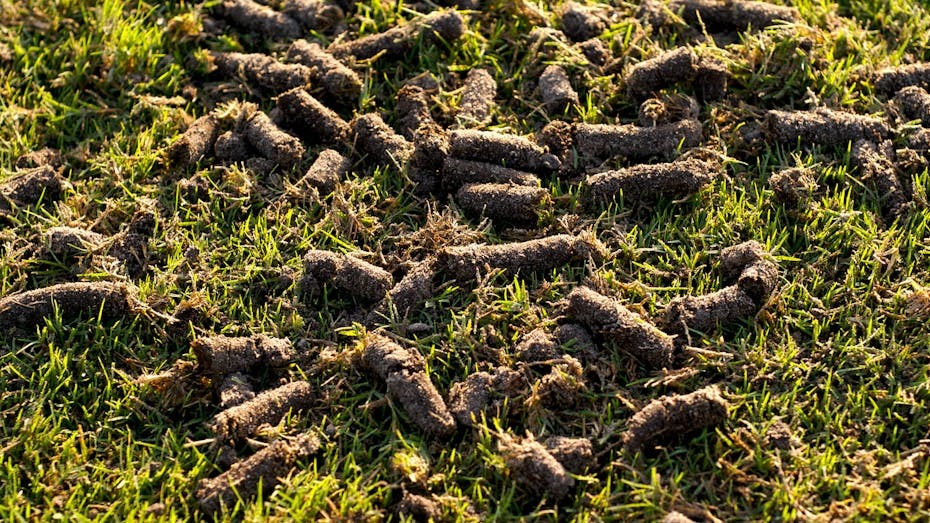
How to Aerate the Lawn
How to make the most out of hollow tine aeration, spiking and slitting to improve compacted lawns, foot paths and play areas.
For lawn aeration using a hand held hollow tine aerator the more holes the merrier so keep it dense with spacing every couple of inches.
If you're spiking using a petrol lawn aerator with solid tines, rolling lawn aerator or aerator sandals just keep going up and down until you've had enough. You really can't overdo it!
For slitting, chisel tining or hollow tine aeration with a machine, one run in one direction is sufficient. Anymore and you may cause some surface disruption. When using a powered lawn aerator to remove cores you may want to avoid running over the cores with the wheels as they will be a swine to remove later on. Which brings me to the next point;
What to do with the cores after hollow tine aeration?
The best thing to do is to let them dry in place and then go over them with the lawn mower with the box off, if the instructions allow. A rotary is ideal to re-distribute the soil from the cores back over the lawn. This also works using a scarifier. This has a double benefit:
- Recycles all the valuable nutrients
- Stimulates bacterial activity and thatch decay
If you are unable to do this for whatever reason then collect the cores by raking with the back of a flat garden, landscapers or hay rake. They can then be smashed and used as a top dressing over the lawn, scattered in the borders or added to the compost heap. DON'T leave them on the lawn to ‘disappear'! They will not completely break down and as you walk or mow over them your lawn will get bumpy.
Brush Sand into the Holes?
I'm often asked about brushing sand into the holes after hollow tining the lawn. They do this on the golf green as part of their top dressing procedure. They also use a soil virtually identical to the original so that the profile remains uniform throughout. Further, they may have to do this several times at weekly intervals after hollow tining because the top dressing only partially fills the hole, and needs 'topping up' over time as it settles.
On a typical lawn you will find it very difficult to get sand or soil to go down the holes; the remaining grass, moss and thatch can easily close over the entrance to the hole stopping the topdressing going in. Trust me; this is a lot harder than it sounds on anything other than a very close mown near flat lawn; and if the lawn or top dressing is anything other than bone dry it'll just stick at the top of the hole!
This is one of the more crazy ideas for a lawn which will cost you too much in material and effort for the dubious benefit that may be derived. Therefore don't bother with this unless your lawn needs top dressing for other reasons, or you have an ornamental lawn and can add top dressing (possibly sterilised so no viable weed seeds!) that is a close match to your own soil at frequent intervals. See Top Dressing Mixes
The Clothes Line and Goal Mouth!
Some areas of your lawn need more aeration to relieve compaction than others. These may be around the clothes line or the postman's short cut across the front lawn. Relieving compaction by spiking with a garden fork or aerator sandals is not that difficult. The secret is to do it frequently, preferably every month. Alternating the aeration with a hollow tine aerator or fork will considerably relieve the compaction. Afterwards, put the sprinkler on the area for 30 minutes and stay off it for a day or two.
If the area gets worn out as well as compacted put a little grass seed in every time you aerate. Not much seed will germinate because of the traffic but enough will grow to keep it looking fairly respectable.
The Air Lift
An alternative to just spiking with a fork is to 'lift' the turf. This is where the fork, once inserted, is levered backwards quite often using your foot as a board behind the fork as a fulcrum. As the fork is pulled backwards the pointy end moves forwards and upwards inside the turf slightly lifting it.
This is very slow and hard work but is very useful for heavily trod areas or where slight depressions have developed and you need to bring the surface level back up to match the surrounding turf.
Hollow Tine Aerating Tips
- Whenever you use a hollow tine aerator make sure you mow the lawn close beforehand. It's the devil's own job to collect or smash the cores in long grass!
- If you prefer to collect the cores get a 'dummy rake'. This is just a flat blade on a stick and moves the cores without snagging in the grass
- If you use the mower to smash the cores you'll need long trousers, wellies and if your soil is clay a pair of goggles won't go amiss as it will get dusty. Shut the house windows as well if it's breezy.
- Finally, if you have used the mower now is the time to clean the air filter, a simple job with a bit of fairy liquid; then swap or sharpen the blade. They're going to need doing anyway!